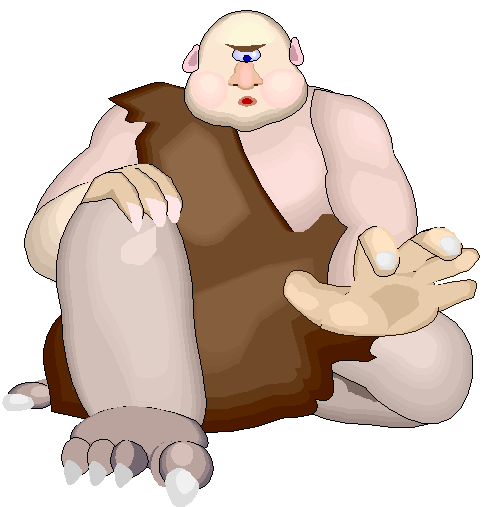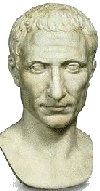|
Aim: Battles of Barletta, Italy
-
Instructional
Objectives:
Students create a
character trait web by brainstorming the traits of giants they have read
about in the past. They will then predict what the story will be
about, while afterwards they will evaluate their thinking.
Students will recall details from their explorations of life in Ancient
Roman times. Students will also work in groups to produce a
research report on Italian geography and culture. They will also
be asked to give an oral presentation to the class.
Time Required:
Activity #1 and The Mysterious Giant of Barletta can be completed within
an hour time frame. Activity #2 could be done within 2 class
periods. However, for students to successfully work on their
reports I would dedicate at least one period a day for about a week and
a
half. Ideally students would meet on their own time outside of
school, but in the past when I've tried this, that just wasn't feasible.
Advance
Preparation: This is an 11th-century legend about a
mysterious giant. The giant statue that has always stood in front of the
Church of San Sepolcro in Barletta is called upon to save the town from
an army of a thousand men that is destroying all the towns and cities
along the lower Adriatic coast.
Materials:
For each student in the class please have a copy of each of the
following worksheets:
Describing Wheel,
Don't Judge A Giant By Its Size, Roman Quiz,Mysterious Giant of Brooklyn,
The
Mysterious Giant of Barletta Word Scramble
. Also give each student
a blank 5X8 index card. Ask each expert to bring in additional
books from the library to complete their research. Here is a link
to the Answer Key
for the quiz.
Vocabulary:
legend, mysterious, expert
Activity
#1:
***Unlike most activities this should be done
 prior
to reading the book with your class. To activate prior
knowledge, display books that have giants as main characters such as,
Jack and The Beanstalk. Have students create a web of
characters traits they believe a giant has. Houghton
Mifflin has a prior
to reading the book with your class. To activate prior
knowledge, display books that have giants as main characters such as,
Jack and The Beanstalk. Have students create a web of
characters traits they believe a giant has. Houghton
Mifflin has a
Describing Wheel that can be
printed out for your students. Students will then go to
All About Giants to read more about these mythical characters.
Have them add on any additional details they find on the web site.
Distribute the following worksheet to your students:
Don't Judge A Giant By Its Size.
Activity
#2:
Have students go to
Roman
Times, a wonderful
 web
site
for elementary students to learn about Ancient Rome. Links
include: Important People, Important Events, Child's Life, Arts
and Crafts. This site also includes an interactive online quiz.
To make sure your children are using the web site correctly, I've created
a printable version of their Roman Quiz,
click here for the Answer Key. web
site
for elementary students to learn about Ancient Rome. Links
include: Important People, Important Events, Child's Life, Arts
and Crafts. This site also includes an interactive online quiz.
To make sure your children are using the web site correctly, I've created
a printable version of their Roman Quiz,
click here for the Answer Key.
Activity #3:
A Jigsaw is a special
 cooperative learning experience for children.
Unlike some group activities where the "strong" students lead the weaker
or lazier ones, in this case each student becomes an "expert" on a
particular topic. The group then forms back so that they get the
"whole" picture of the subject being studied. For more information
on this type of set-up see The
Jigsaw Classroom in 10 Easy Steps. Break your class up into
groups of 5. Assign each person a role:
Geographer,
Chef,
Musician,
Scientist, and
Artist.
Have them click on the link of their title to find out information about
their topic. Students will work together to create a report
covering all of their individual topics. In addition, groups will
be required to present their findings to the class in a 6-10 minute oral
report. Students can read a sample research report at
Writer's Showcase Research Report.
Students will write their own original stories titled
The Mysterious Giant of Brooklyn. Distribute copies of the following worksheet to give students a
guideline for their writing.
Mysterious Giant of Brooklyn
Extension#2:
Students will write a diary entry of a day in the life on an ancient
Roman. Students may go to
Ancient Rome
Daily Life for more ideas and inspiration.(Another informative site
created for younger students)
Extension
#3: As a celebration of learning a little about
Italy's culture have students go to
Children's Conversational Italian to learn a few phrases in Italian. cooperative learning experience for children.
Unlike some group activities where the "strong" students lead the weaker
or lazier ones, in this case each student becomes an "expert" on a
particular topic. The group then forms back so that they get the
"whole" picture of the subject being studied. For more information
on this type of set-up see The
Jigsaw Classroom in 10 Easy Steps. Break your class up into
groups of 5. Assign each person a role:
Geographer,
Chef,
Musician,
Scientist, and
Artist.
Have them click on the link of their title to find out information about
their topic. Students will work together to create a report
covering all of their individual topics. In addition, groups will
be required to present their findings to the class in a 6-10 minute oral
report. Students can read a sample research report at
Writer's Showcase Research Report.
Students will write their own original stories titled
The Mysterious Giant of Brooklyn. Distribute copies of the following worksheet to give students a
guideline for their writing.
Mysterious Giant of Brooklyn
Extension#2:
Students will write a diary entry of a day in the life on an ancient
Roman. Students may go to
Ancient Rome
Daily Life for more ideas and inspiration.(Another informative site
created for younger students)
Extension
#3: As a celebration of learning a little about
Italy's culture have students go to
Children's Conversational Italian to learn a few phrases in Italian.
- Homework:
During class have students visit
Photo Gallery of Barletta. Distribute blank 5X8 index cards, have students create Postcards From
Italy. On the front they will draw an aspect of Italy or Italian culture
they have learned about, on the back they are to write to a friend about
what they have learned and "seen" in Italy. Also distribute the
word puzzle created by Houghton Mifflin Reading The
Mysterious Giant of Barletta Word Scramble
.
- Evaluation:
With activity #1
you want to see that a student's predictions have changed. For
most students, they will have many negative ideas about giants.
After reading the book, their opinions should change. With
activity #2 you will have an actual test score to see how much
information was retained. For the jigsaw report students should
get 2 grades- grade them as a group and give each member an individual
grade. Here is a good example of a rubric for cooperative learning
activities
Group Rubric.
|
 cooperative learning experience for children.
Unlike some group activities where the "strong" students lead the weaker
or lazier ones, in this case each student becomes an "expert" on a
particular topic. The group then forms back so that they get the
"whole" picture of the subject being studied. For more information
on this type of set-up see The
Jigsaw Classroom in 10 Easy Steps. Break your class up into
groups of 5. Assign each person a role:
Geographer,
Chef,
Musician,
Scientist, and
Artist.
Have them click on the link of their title to find out information about
their topic. Students will work together to create a report
covering all of their individual topics. In addition, groups will
be required to present their findings to the class in a 6-10 minute oral
report. Students can read a sample research report at
Writer's Showcase Research Report.
cooperative learning experience for children.
Unlike some group activities where the "strong" students lead the weaker
or lazier ones, in this case each student becomes an "expert" on a
particular topic. The group then forms back so that they get the
"whole" picture of the subject being studied. For more information
on this type of set-up see The
Jigsaw Classroom in 10 Easy Steps. Break your class up into
groups of 5. Assign each person a role:
Geographer,
Chef,
Musician,
Scientist, and
Artist.
Have them click on the link of their title to find out information about
their topic. Students will work together to create a report
covering all of their individual topics. In addition, groups will
be required to present their findings to the class in a 6-10 minute oral
report. Students can read a sample research report at
Writer's Showcase Research Report.





 prior
to reading the book with your class. To activate prior
knowledge, display books that have giants as main characters such as,
Jack and The Beanstalk. Have students create a web of
characters traits they believe a giant has. Houghton
Mifflin has a
prior
to reading the book with your class. To activate prior
knowledge, display books that have giants as main characters such as,
Jack and The Beanstalk. Have students create a web of
characters traits they believe a giant has. Houghton
Mifflin has a
 web
site
for elementary students to learn about Ancient Rome. Links
include: Important People, Important Events, Child's Life, Arts
and Crafts. This site also includes an interactive online quiz.
To make sure your children are using the web site correctly, I've created
a printable version of their
web
site
for elementary students to learn about Ancient Rome. Links
include: Important People, Important Events, Child's Life, Arts
and Crafts. This site also includes an interactive online quiz.
To make sure your children are using the web site correctly, I've created
a printable version of their 